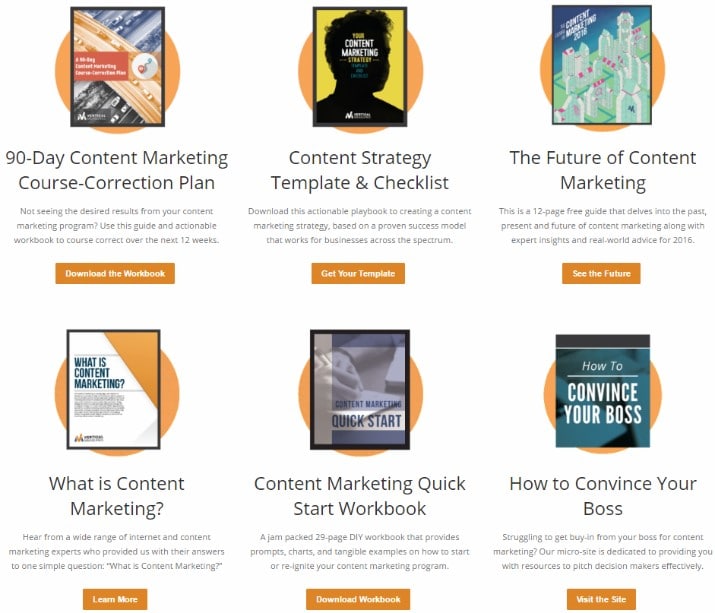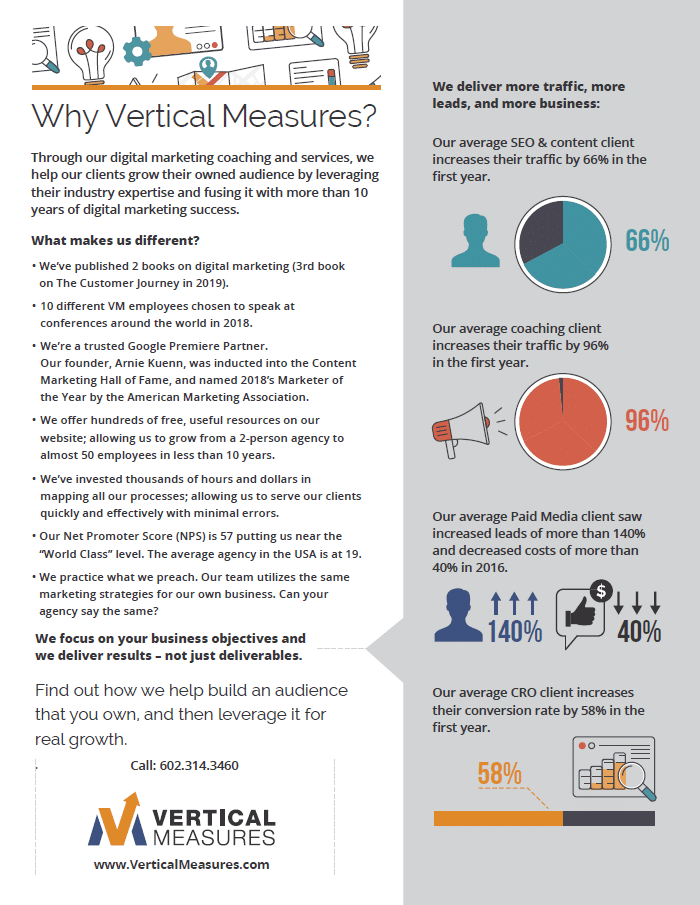Get our 13-page template that will help you create or re-ignite your content marketing strategy. Sit down with your team to use this in a brainstorming session! Get the template now!
As we’ve preached for years: If you have a website, you’re a publisher, and you must start thinking like one! If you’re not producing fresh content on a regular basis, you’re already behind. Print publishers create content to survive because that’s their business. On the Internet, it’s the same for you. You need to keep thinking about content ideas all the time, and encourage your entire staff to do the same.
You can certainly create a killer blog or podcast as the cornerstone of your content portfolio. But it’s more efficient and effective in the long term (and necessary for larger organizations) to take a broader view – to create content that can come to life in various formats, across many different platforms, and that can address multiple audiences.
In the spirit of Halloween (yes, it’s that time of year already), we’re going to highlight the best types of content that will rock your inner monster, and generate the best results for your business – regardless of your industry!
Please note: Each content option has a merit of its own and should be judged separately on its value to your content marketing strategy. We do not recommend tackling all of them unless you have significant resources available. If you want to try creating the content examples below, only select the ones that you feel confident in and will allow you to do a stellar job.
Content Ideas So Good, They’re Scary
1. Infographics
An infographic is a piece of content that visually represents information using images and words, and they’re a great way to communicate with your audience in an interesting and condensed format. The possibilities with infographics are nearly endless and make content easily digestible for the short attention-spans online. Everybody seems to love them because they’re fast to read, and are perfect for passing around via social media.
Most people would prefer to look at a picture quickly, rather than read a whole article, especially in the middle of a busy day. Time is valuable, and infographics save quite a bit of time. Because of their appeal, infographics can drive a lot of links to your website. When someone finds an infographic that they think is really cool, they will link to it from their page, embed it on their site, or post it on their blog. In other words, they make great linkable assets.
If you have a website, you’re a #publisher, and you must start thinking like one!
By generating your own infographics, you’ll benefit from all the traffic, citations and backlinks. On top of that, the content of the infographic should be the kind of information that demonstrates your inside understanding of the market or industry your business is in. Fundamentally, there’s nothing wrong with posting someone else’s infographic on your site, but if you can go the extra mile and generate your own, you’re going to be much better off.
Trick for a Treat
It’s not as hard as you might imagine developing an infographic. All you need to do is identify a concept and supporting data, then ship it off to a graphic designer. They’ll find a clever way to present the data in an easy-to-read format. A graphic designer can’t complete everything for you. They can develop a color scheme and some of the visual elements of an infographic, but you’ll need to provide them some important details to get them started.
2. Videos
Think about videos you’ve seen on the Internet that would never meet quality standards for television production or advertising but have made a point that you nodded your head to. Maybe your favorite blogger is sitting at a bistro in San Francisco and is leaning into a video camera that’s propped on the table and he’s discussing a fantastic strategy for your industry.
The quality and film angle would never say “professional” in other media outlets, but it works great online. The benefit of this is that the users feel like they’re right there with you, getting a personal lesson. In fact, a video that gets momentum and goes viral tends to be filmed on the spur of the moment.
Short, 2-5-minute videos are best because viewers tend to have short attention spans for online video content. Within those constraints, video can be used for anything – videos can be educational or entertaining. The only limit is the imagination.
There are many places to post a video. Everyone knows YouTube, but there’s also Vimeo, SlideShare, and other sites. This gives you the ability to post your videos on multiple channels and reach the maximum audience. If you optimize your videos and get people to talk about them, they can do well in search, directing traffic to your website as a result.
Release your inner monster – don’t be timid! Get in front of the camera and become an office celebrity.
While professional video production can be expensive, do-it-yourself camera work is very low-cost. To start, encourage your staff to shoot videos and get everyone thinking, “How can this be recorded and how can it become content?” Release your inner monster – don’t be timid! Getting in front of a camera may be easier said than done, but you have to get over it if you’re going to do video content. Maybe someone in your office has a great presence on the camera, so they become a bit of an office celebrity.
While you can’t force a video to take off, you can develop quality video content that has appeal. Being of quality means it offers some kind of real value to the viewer; it’s not just noise. It shows your industry knowledge and experience, capturing your brand within that context.
By establishing a standard for the quality of your content and having fun at the same time, you will improve your chances of creating a video that will increase your traffic, generate leads, and maybe, just maybe, skyrocket to viral.
Trick for a Treat
Video is a medium that can be taken too seriously, but really works best when the atmosphere is relaxed and fun. Work towards creating a fun environment with shooting video, and shake off those pesky nerves. Being confident and having fun while recording will result in better video content.
3. Webinars
Webinars are web-based seminars or live presentations where users remotely engage from their desktops. This type of content is a fantastic way to bring customers together from anywhere on the planet. To manage the connectivity and presentation, you can use a webinar service, such as GoToMeeting.com, Zoom, On24.com or Webex.com.
Yet another tool for showing your industry knowledge, webinars are excellent ways to directly engage customers, and potential customers, with solutions to your industry’s toughest problems. Through a webinar, you have an extended time with your audience, which gives you the ability to show your leadership and depth of knowledge.
Anyone can do a webinar on any subject, and I’m a little baffled that businesses don’t them more often. Webinars aren’t just for business executives. You might be surprised to discover that there’s a wide range of people out there willing to attend them. For example, REI hosts a number of webinars, with topics ranging from choosing the best hiking boots to finding the roomiest tents.
Depending on how in depth you go with the subject matter, they don’t take long to prepare, either. Generally, you put together a PowerPoint and walk through it online. From your PowerPoint, you can link out to other sites or other content that you’ve created on the topic.
Because webinars require registration to participate, you can acquire the name and email of all participants, which you can add to your eNewsletter list, as well as your contact list for leads.
Registrants are harder to obtain than you think. The real challenge with hosting a webinar is that you need people to show up in order to have some level of success. This means that you will need to use promotion tools – Twitter, Facebook, press releases, you name it – to get the message out that you have a webinar coming up.
Use all promotion tools to get the message out about your #webinar. Registrants are harder than you think to obtain.
You’ve got to push it. When you host webinars on a regular basis, you help establish a set of returning participants. If they like what they’re getting, and they know exactly when the next one will be, it’s much easier for them to come back.
Trick for a Treat
Leave time for a question-and-answer session at the end. As people interact with the content that’s being presented, you can capture all that activity when you record the session. That human interaction is another way to show your ability to contribute solutions to your customers in a direct way.
4. Podcasts
A podcast is basically a non-streaming webcast, in audio or video form. Podcasts are typically downloaded through web syndication via a Podcatcher. The Podcatcher is a software client that downloads podcasts and can manage the transfer of files to a portable media player.
iTunes is by far the most popular Podcatcher, but there are many services that can catch podcasts. Audiences typically subscribe to a podcast channel, so whenever you publish a new podcast, it gets distributed to all the subscribers, automatically.
For a minimum of effort, podcasts can provide a huge bonus of expanded distribution of your #content.
Since podcasts can be either audio or video, they are great ways to publish those kinds of media and to effortlessly distribute them to subscribers. The popular term “podcast,” as opposed to “webcast,” came about with the invention of the iPod, so podcasts are often associated with audio syndication.

Many radio news outlets, for example, make use of podcasts as a way to distribute their news, sometimes even parsing it out by topic (music, sports, politics, business, etc.). Podcasts are a huge distribution channel, so it can help with building your brand, image, and authority. Because Podcasts can be forwarded, they, too, have the potential to go viral.
What’s great about audio is that you can use it to turn your blog posts into podcasts. You could record someone reading your text blog post into a microphone if you want a human narrator. Any audio you produce for your web pages should be podcasted. For a minimum of effort, you get the huge bonus of expanded distribution of your content.
Trick for a Treat
Many people continue to use podcasts for audio. Don’t discount the value of audio in favor of video – audio can fill a niche and connect with your followers in a way that video cannot do. For example, they can download their latest podcast and listen to the newest audio files while commuting or working out at the gym.
5. Case Studies
Broadly, case studies are research reports that isolate a group, event, or individual for in-depth analysis. A case study should analyze your customer’s situation, their problem, and your solution, detailing how it led to your customer’s success. They can vary in length and form, from a brief paragraph to a full report. Case studies can include graphics and charts, and even video testimony, in addition to text.
These are excellent for touting your results, showing precisely how others have succeeded because they’ve worked with you, complete with tangible examples of your expertise. Case studies have many applications, ranging from blog posts, to inclusion in an eNewsletter, to a section on your website devoted to case studies – or you could repurpose the case study for all three places!
The main challenge with case studies is actually getting your client to cooperate with you. You need information from them before you can create the case study. Sometimes, it can become difficult tracking your clients’ successes if they don’t provide access to their analytics. Depending on your client, it can take some effort to get them to provide you with the information you need to create the study. With that said, pitching the idea of developing a case study can be relatively easy – especially when it offers a chance to give your client some positive exposure.
Trick for a Treat
A great place to post case studies is the “About Us” section of your website, or you could offer three or four brief case studies on a page that is linked to from your “About Us” section. This is where potential customers will go to find out who they’re about to do business with. Case studies work especially well when they are quick and easy to read.
6. eBooks
People who follow Vertical Measures know that we love eBooks. These short or long PDF documents often contain interesting graphics and are chock full of useful information. When executed well, eBooks can generate a large number of leads by gating content behind a lead capture form and requiring users to fill out information before gaining access.

Examples of gated content from Vertical Measures
#eBooks are premium #content that provides direct value depending on our audience’s needs.
eBooks offer your target audiences a robust piece of information that will help establish your brand as a trusted authority in the industry. To us, there are 3 reasons why eBooks work:
- They’re great lead generators: All you need to do is put a little lead capture form in front of that content. Maybe just ask for somebody’s name and email address to get this free download. Or if it’s a really spectacular piece of content, you can ask a few more qualifying questions. But either way you’re building your contact list and you’re building your leads.
- They attract links: We’ve got plenty of examples where eBooks generated dozens, if not hundreds, of backlinks for our website. Why? Because, it’s exactly what another webmaster or a blogger is willing to divert their traffic and their customers to a rockin’ piece of content. Keep in mind, however, if you decide to gate the eBook behind a lead capture form, the number of backlinks you receive may decline.
- They have a really nice, hopefully long lifespan: eBooks become the perfect evergreen content. We’ve got a few cases where we’ve built eBooks for our clients five or six years ago, and we’ve only had to refresh them once or twice along the way (updating internal links, outdated statistics, etc.). Today, they’re still sitting out there generating leads, links for their websites (and ultimately revenue) well after they were originally created.
An investment of maybe $1,000, $2,000, or even $5,000 can have an almost immediate payback – and after that – it sits there, quietly working for you. It’s generating those leads, links and hopefully revenue for your business, and that’s why I love free guides (and whitepapers).
Trick for a Treat
eBooks are a great way to generate leads, but gating the wrong content at the wrong time during your customer’s journey can discourage potential clients from continued engagement with your brand. However, gating the right content at the right time can help you nurture budding leads, while supporting a trusting relationship and potentially boosting revenue down the road.
7. Interactive Content
Even when we do create an awesome eBook, case study, or blog post, it can be really challenging to make it stand out amongst the crowd of similar content. There’s real strategy involved in convincing your audience, “This isn’t just another piece of content on our blog”. You must continue searching for ways to keep them interested.
Engaging a target audience is consistently one of the toughest challenges for marketers. It’s also one of the most important jobs of any piece of content you create. That’s what makes interactive content so useful. At its most basic, interactive content is designed to engage with your audience in a way that the above examples cannot.
Success in digital marketing – specifically with content – means your audience is not only consuming your blog posts, videos, podcasts, etc., but also engaging with it. As more marketers are fine-tuning their strategy to generate engagement with their content, static content is becoming lost in the noise and interactive content is crowd-surfing to the stage.

You’re not going to get an audience to the merch booth until they have a little fun in the mosh pit.
Successful interactive content allows your audience to enjoy the show, and gain insight without feeling targeted by a brand. Like general digital marketing tactics, good interactive content doesn’t throw aggressive CTAs, or unwelcomed sales pitches. You’re not going to get an audience to the merch booth until they have a little fun in the mosh pit. But that doesn’t mean this type of content won’t generate results for you right away. Check out some research from our friends at Content Marketing Institute:
- Online quizzes with images or GIFs are 40 times more likely to be shared on social networks.
- 88% of marketers who use interactive content say their content was somewhat effective or very effective in differentiating it from competitors.
- 81% of marketers think interactive content grabs readers’ attention.
- 51% of marketers say online calculators are most effective in the “Consideration Stage” of the customer’s journey.
Wondering how to create interactive content for your blog? Zembula put together an awesome list of tools that will help create a more engaging (and rewarding) experience for your audience.
Trick for a Treat
Believe it, or not, interactive content requires some background knowledge on conversion rate optimization. Instead of traffic or click-thru rate (CTR), measure the content’s success by total shares or average session time. The longer your audience is on the page, engaging with and sharing your content – the better.
Publish, Publish, PUBLISH!
You can’t create something cool once and let it sit idly online, expecting it to be cutting edge or consistently relevant to users. Instead, your job as a digital marketer is to keep producing fresh material, even repurposing your best content, so that it reappears in a fresh form and gives you as many different opportunities to be found online as possible.
Remember to foster a fun environment where creative expression is valued. The more you encourage creativity, the more you can gain from your digital marketing strategy.
And always remember, just because you wrote it, took a picture of it or shot a video, it doesn’t mean you have to publish it. But you must start creating content with the intent of using it.
Content Marketing Strategy Template
Get our 13 page template that will help you create or re-ignite your content marketing strategy. Sit down with your team to use this in a brainstorming session!
The post 7 Types of Content That Will Rock Your Inner Monster (Regardless of Industry) appeared first on Vertical Measures.
Related Stories
- Six Questions Digital Marketers Get Asked All The Time
- A Marketer’s Guide to Website Accessibility: The Importance of Inclusive Design
- The Weekly Measure: Data-Driven Content, Defeating Amazon & Fake YouTube Views
source https://derekpackard.com/7-types-of-content-that-will-rock-your-inner-monster-regardless-of-industry/




No comments:
Post a Comment